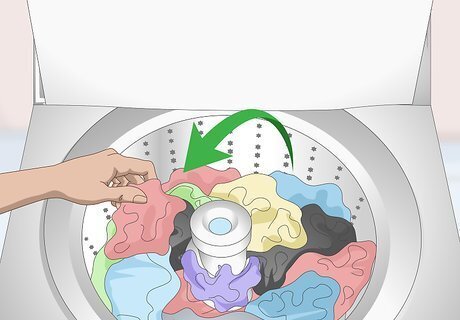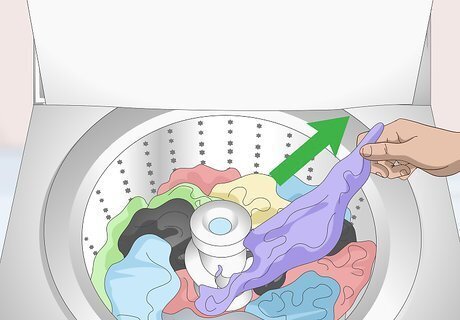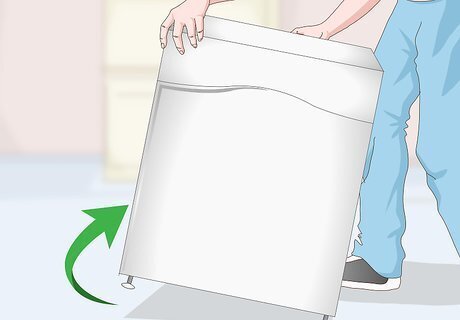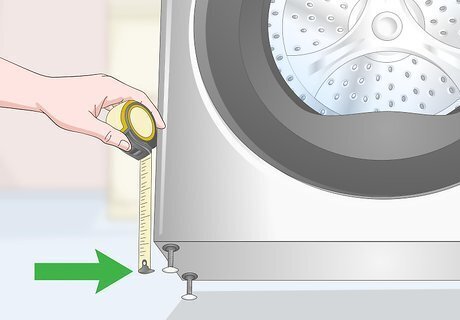
views
- If the washing machine is making noise, stop your wash, check if your load is unbalanced, and then evenly spread the clothes across the washing machine.
- You may need to remove clothes that are wrapped around the agitator or take clothes out if your machine has been overfilled.
- Make sure your machine is level by measuring the legs on your washing machine and checking that the floor under it is flat.
Checking the Distribution of Clothes

Stop the machine right when it is rumbling and making noise. Normally, you can stop a washing machine by simply lifting the lid if it is a top load, or opening the door if it is a front load. If this isn’t the case or the door won’t open, look for a “pause” button on the control panel on the top of the machine. Make sure to stop the machine in the middle of a cycle as this method relies on there being an issue with the way that the clothes are arranged inside the machine. If an incorrect distribution of clothes does end up being the issue, then running the machine without any clothes in there won’t actually indicate any issue to you.

Open up the machine and look for an uneven distribution of clothes. Try and see whether a bunch of clothes have ended up on one side or in one particular area. Don’t worry about moving them at the moment, just take a look. This is the single most common cause of an unbalanced washing machine. Clothes can often get caught up in one area of the drum which results in more weight on one side. This is why you often hear a rhythmic banging while the machine is running. There needs to be a fairly severe imbalance of clothing distribution for this to be the cause, so you'll be able to see the clothes very obviously bunched up.

Redistribute clothes that are bunched up in one area. Try to make it so that all areas of the washing machine have roughly the same number of large and small items of clothing. If you have trouble with this, just count out the number of large and small items you put on each side. It can also help to spread out any clothes that have become bunched up such as a pair of jeans or some other item made of heavy material. The machines work much more efficiently when each item of clothing is spread out normally. Very large items like bed-sheets or towels shouldn’t be washed on their own as they have a tendency to end up in one area. With no other items to act as a counterweight, this can often throw your machine into imbalance.

Move clothes that are wrapped around the agitator, if you have one. This is specific to people with a top load washing machine. Take these clothes away from the agitator and re-distribute them evenly throughout the machine. The agitator is the pole-like thing that sticks up in the middle of a top-load washing machine. The reason it is there is to help move the items in the machine around, so they are more effectively washed. Clothes often get wrapped around the agitator which can result in the clothes bunching up. This, in turn, causes the machine to end up unbalanced.

Remove some clothes from the machine if it is overfilled. This is another very common cause of machine imbalance. Look for a visual guide on the side or top of the machine showing how full your machine should be. Most washing machines aren’t designed to be packed anywhere near to the top before starting the cycle so ensure that there is still plenty of room in the drum. Overfilling is a common occurrence with people trying to get a lot of washing done at once so if you’re close to being full, just split it up into two loads.
Making Sure the Machine Is Level

Tilt the washing machine backward so the front legs are exposed. Get someone to help you while you’re doing this as you won’t be able to hold the machine in place and also perform the next steps. Also be careful that you don’t tip the machine so much that any connections to hoses or cables are stressed. Doing this allows you to get a look at the front legs of the washing machine. The legs of the machine form the platform which it sits on. When the legs aren’t even, the machine tends to shake during the spin cycle. If you don’t have someone to help you hold the machine up, use a piece of wood under the front of the machine to help prop it up.

Check that the legs are the same length. Feel free to use a tape measure or even just a small ruler. Try and be as accurate as possible as once a machine gets onto the spin cycle, even a small difference in the legs can cause fairly significant lurching and bumping. All four of the legs should be in firm contact with the floor. If you can’t seem to find any difference in length when measuring, put the machine back onto the ground and take a look at the legs to see if they look even. Most machines have self-adjusting rear legs so don’t worry about these.

Adjust the front legs so they are the same length, if necessary. Twist the front legs with your hands so they are the same length. Many legs of machines will have a nut that you must loosen with a wrench first in order to shorten or extend the legs. Once you’ve loosened the nut, you’ll be able to rotate the legs by hand. Sometimes, rust can build up on the nut which prevents you from adjusting the length of the leg. If this is the case, tap the leg a few times with your wrench. This should help dislodge the rust. Make sure you tighten the nut back onto the leg once you're finished adjusting the length of the leg.

Check that the floor surface that the machine is on is even and flat. Look at whether your surface is tiled or whether one of the legs is on some kind of downslope or something like that. It’s really common for people to forget that one of the legs may be sitting on a gap between tiles, or one of the legs might be right up against the wall where the floor surface is different from the rest of the floor.

Adjust the washing machine so it is sitting on a solid surface. Use rubber vibration absorbers or even little squares of carpet if you need to. You can find these online or at your local home goods store. To install the vibration absorbers, have someone help you tilt the machine backward and then forward so you can slip the discs under the legs of the machine. This process is the same for carpet squares however the rubber discs tend to be more effective as the carpet squares sometimes have a tendency to slip.

















Comments
0 comment